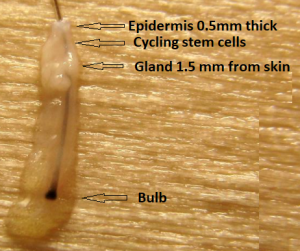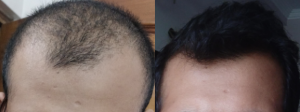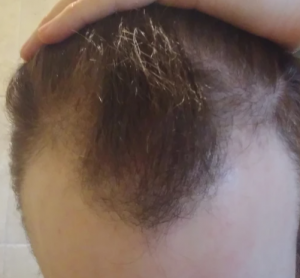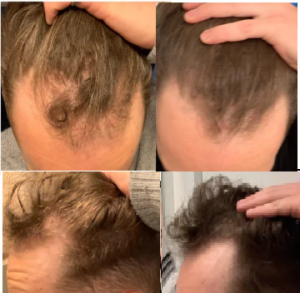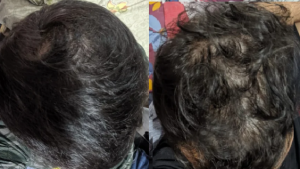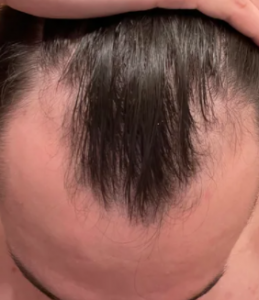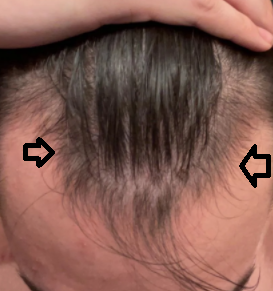Asking on behalf of my dad. He’s 61, and I just started microneedling and telling him about it. All he has is his sides and I’ve remembered him like that for as long as I can remember (I’m 24) He seems interested in trying it and I’m letting him borrow my pen. Is there any chance of anything happening. He seems quietly interested in it, so much so that he’s wanting to try it tomorrow. But I don’t want him getting hopes up if that’s something that’s too far gone. Can follicles be dormant for so long that they just can’t be revitalized?
I would imagine that microneedling in a person who has been bald for 20 years would not produce growth because these hairs went through apoptosis (cell death) years ago and probably the hair can’t be brought back.
I want to help her and buy her a derma roller at the least but how do I have that conversation with her without destroying her self esteem
She should see a doctor. Female hair loss is very different than male hair loss as there are many common conditions and this could be a sign of some important change in her overall health or some disease of the hair and scalp more common in women then men. Dermarolling is not the answer for most women unless they have genetic balding and female patterned hair loss.
I am losing a lot of hair so I can’t tell if I am balding but I suspect so.
For some men like you, it is very difficult to tell early balding. Before you begin the treatment journey, you must have a diagnosis. A HAIRCHECK test (https://baldingblog.com/haircheck-test-how-it-is-done-video/) will give you an objective measurement and determine if your balding and it can also be repeated to show what is happening to you over time
J Eur Acad Dermatol Venereol
2022 Feb;36(2):286-294.
doi: 10.1111/jdv.17738. Epub 2021 Oct 25.
Efficacy and safety of topical finasteride spray solution for male androgenetic alopecia: a phase III, randomized, controlled clinical trial
B M Piraccini 1, U Blume-Peytavi 2, F Scarci 3, J M Jansat 3, M Falqués 3, R Otero 3, M L Tamarit 3, J Galván 4, V Tebbs 5, E Massana 3, Topical Finasteride Study Group
Abstract
Background: Oral finasteride is a well-established treatment for men with androgenetic alopecia (AGA), but long-term therapy is not always acceptable to patients. A topical finasteride formulation has been developed to minimize systemic exposure by acting specifically on hair follicles.
Objectives: To evaluate the efficacy and safety of topical finasteride compared with placebo, and to analyse systemic exposure and overall benefit compared with oral finasteride.
Methods: This randomized, double-blind, double dummy, parallel-group, 24-week study was conducted in adult male outpatients with AGA at 45 sites in Europe. Efficacy and safety were evaluated. Finasteride, testosterone and dihydrotestosterone (DHT) concentrations were measured.
Results: Of 458 randomized patients, 323 completed the study and 446 were evaluated for safety. Change from baseline in target area hair count (TAHC) at week 24 (primary efficacy endpoint) was significantly greater with topical finasteride than placebo (adjusted mean change 20.2 vs. 6.7 hairs; P < 0.001), and numerically similar between topical and oral finasteride. Statistically significant differences favouring topical finasteride over placebo were observed for change from baseline in TAHC at week 12 and investigator-assessed change from baseline in patient hair growth/loss at week 24. Incidence and type of adverse events, and cause of discontinuation, did not differ meaningfully between topical finasteride and placebo. No serious adverse events were treatment related. As maximum plasma finasteride concentrations were >100 times lower, and reduction from baseline in mean serum DHT concentration was lower (34.5 vs. 55.6%), with topical vs. oral finasteride, there is less likelihood of systemic adverse reactions of a sexual nature related to a decrease in DHT with topical finasteride.
Conclusion: Topical finasteride significantly improves hair count compared to placebo and is well tolerated. Its effect is similar to that of oral finasteride, but with markedly lower systemic exposure and less impact on serum DHT concentrations.
Disclaimer
The information contained in this communication from the sender is confidential. It is intended solely for use by the recipient and others authorized to receive it. If you are not the recipient, you are hereby notified that any disclosure, copying, distribution or taking action in relation of the contents of this information is strictly prohibited and may be unlawful.
This email has been scanned for viruses and malware, and may have been automatically archived by Mimecast Ltd, an innovator in Software as a Service (SaaS) for business. Providing a safer and more useful place for your human generated data. Specializing in; Security, archiving and compliance. To find out more Click Here.
I am an avid ocean sports person who would like to try dermarolling. However I am unsure how long I would need to wait before returning to the ocean if I wanted to dermaroll once a week? I have seen articles online telling people who get tattoos to stay out of water or risk infection for 2 weeks and i know those needles are about close to 1.5mm the same as a dermaroller
The wounds from a 1-1/5 dermroller should seal within 2-4 days, so you can comfortably go into the water after 4 days.
How effective is finasteride at stopping hair loss? I am 19 and have a receding hairline but thankful I caught it early. Started finasteride and just wondering if it can stop hair loss all together
Stopping hair loss with finasteride depends a great deal on your genetics. Finasteride can’t always stop your patterned hair loss if it is very aggressive. There is a high probability that finasteride will either slow, stop or reverse the hair loss. When it slows it down, it is hard to see because there is nothing to compare it to; however, if you are on finasteride for a long time and then stop it, “catch-up hair loss” will show that it was working. I wouldn’t advise someone to do this because there is no guarantee that the ‘catch-up hair loss’ can be fully reversed.
Doctor, is it normal for even people without hairloss to shed hair in the shower, on the comb, etc? As they say 50-100 hairfall is normal.
50-100 hairs per day is the normal shed through the day and the same number of new hairs start growing out that same day to keep the total number of hair on your head the same over time
I’m wondering if there are people here who had a transplant done at a late age, let’s say 40, and given their balding pattern and high quality of their donor hair they opted for not taking meds (fin, min, etc) and were mostly fine for 5-10 years, doing another procedure then.
If someone has bad sides from fin and their balding is not that aggressive (plus good donor area and cash) I think this would be a fine strategy. For example, for mature NW3+ people who just want to fill the crown.
When I perform a hair transplant on a 40 year old without recent hair loss, I don’t feel that finasteride is needed if the patient doesn’t want to take it. Shock loss from the hair transplantation in men without recent hair loss not common
If I apply minoxidil only on crown then will it protect hair where it’s applied or the entire head?
Applying minoxidil topically impacts the area where you apply it, not other parts of the scalp; however, there is overflow and some systemic absorption. My wife took it for her hairline, but it caused facial hair to grow showing some systemic spillover.
Page 107 of 1234

